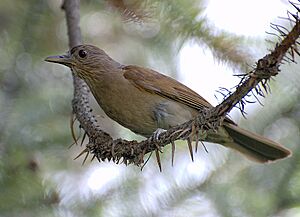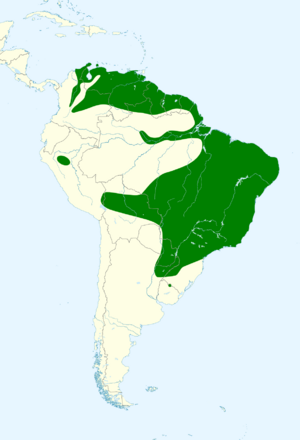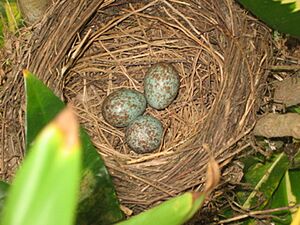Pale-breasted thrush facts for kids
Quick facts for kids Pale-breasted thrush |
|
|---|---|
 |
|
| An adult pale-breasted thrush in São Paulo, Brazil | |
| Conservation status | |
| Scientific classification | |
| Genus: |
Turdus
|
| Species: |
leucomelas
|
 |
|
The pale-breasted thrush (Turdus leucomelas) is a common bird found in many parts of South America. It belongs to the Turdidae family, which includes many types of thrushes and robins.
This bird is known for its light-colored chest, which gives it its name. It is a very adaptable bird that often lives close to people.
Contents
Where Does the Pale-Breasted Thrush Live?
The pale-breasted thrush lives in many different places across eastern and northern South America. You can find it in countries like Brazil, Colombia, and Uruguay. It prefers areas with trees and bushes, like forests and woodlands.
Living Near People
These birds are quite good at living near humans. They are often seen in towns and cities. You might spot them nesting in garden shrubs or small trees in your backyard.
In Suriname, people call this bird "Boontjedief." This means "bean thief" in Suriname Dutch. They got this name because they sometimes pick up beans left out to dry in the sun! In proper Dutch, it is called "Vaalborstlijster." In Sranan tongo, another local language, it is known as "Bonka."
What Does the Pale-Breasted Thrush Look Like?
The pale-breasted thrush is about the same size and shape as the American robin. However, it does not have the bright red chest that the American robin has. Instead, it is mostly brown all over its body.
How to Tell Them Apart
It can sometimes be confused with another bird called the creamy-bellied thrush. But there are a few ways to tell them apart:
- The pale-breasted thrush has a clear difference in color between its head and its back.
- It does not have dark markings around its eyes, unlike the creamy-bellied thrush.
What Do They Eat?
The pale-breasted thrush enjoys a varied diet. They mostly eat different kinds of fruits. But they also like to snack on worms, insects, and even small lizards.



